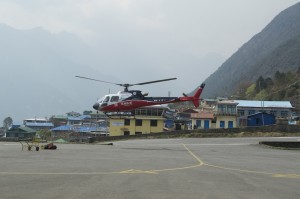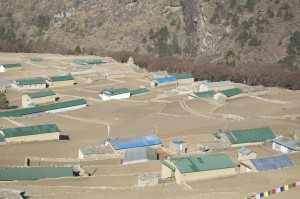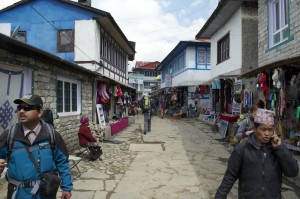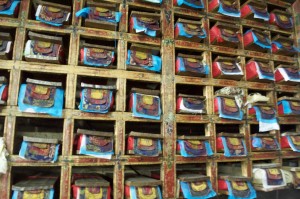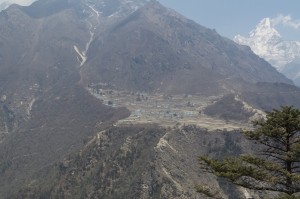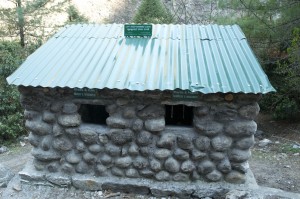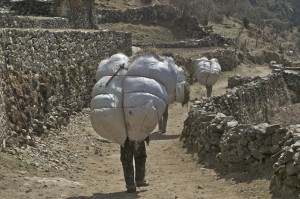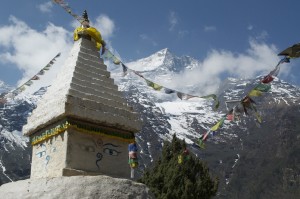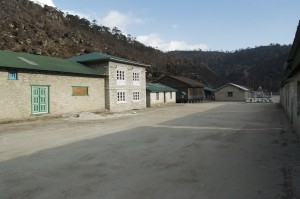Hira’s brother met me at the airport and a car took me to the International Guest House on the outskirts of Thamel. The hotel was not too bad but its position in relation to its surrounding was a bit of a let down. It was perfectly adequate for me but not really suitable for a group. Like so many hotels in Kathmandu it lacked some of the finer details. The bathroom was quite basic and the only cosmetic available was a small bar of green soap. It would have been no trouble to provide a small basket with a selection. The white towels were really off-white veering towards grey. Things looked up a bit when the cupboard beneath the antique television set contained a minibar fridge. Sadly it was not only empty but also not switched on so I couldn’t even keep my bottled water cold. Beyond the room the public areas were quite pleasant but could probably do with a fresh coat of paint. Slightly disconcertingly, there were easy chairs on the open corridors. I had one outside my door and beneath my bathroom window. I never did get used to opening my door and finding somebody sitting there. The small square garden also doubled up as a dining area with tables on two sides. Half were under cover, which during daylight hours were preferable as the outside tables were plagued by flies. The most disappointing aspect of the area was the sullen, somewhat dishevelled waiter who shuffled around, could not muster up a smile and appeared to be totally disinterested in the customers or the job he was doing. Plates of food were ungraciously placed before me. Clearly he was not working on receiving a tip. He would have been more at home at Fawlty Towers.
You would have thought that by being in Kathmandu that communication using a mobile phone would have been easier. Far from it. My mobile, which had worked almost anywhere in the mountains, now was rendered useless. It was impossible to both make and receive calls. It was the same for texts, unless they were very short and to the point. Fortunately email worked but, having decided that I would use my time to deal with all the charitable issues, communication became a bit of a nightmare.
One of the reasons for returning to Kathmandu was to make best use of my time instead of idling the days away in Lukla. One of my objectives was to hand over a significant sum of money to Tashi Waldorf School for whom KSWNT had accrued funds. This was beginning to prove to be a lot more difficult than you would imagine. Before I left England I emailed the director to advise her of my intentions. Unfortunately that communication bounced back because her in box was full. Never mind, a visit will not go amiss, particularly as I have unexpected time on my hands. So, having showered and breakfasted, I first visited my friendly money changer and exchanged a large(ish) bundle of £20 notes for an even larger bundle of Nepalese Rupees.
I cannot visit the money changer without Azam, the next door jeweller, coming to see me because he has recognised my voice. Over the years I have put quite a bit of business his way. I think he is good but he is never happy about the level of business he achieves on a day to day basis; he is not right in the hub of the tourist area and there is lots of competition nearby. However, on this occasion he does not want to sell me any jewellery but would like to chat about marriage, if I had time. I explained that I had to visit Tashi Waldorf but then I would come and see him. By this time a taxi driver I have known for years and who hangs about outside the Marshyangdi Hotel opposite came to see me.
All these acquaintances took time and it was clear that I was not going to get the job done before I had to meet Hira for lunch. Tashi Waldorf would have to wait until the afternoon when I would return to have a chat with Azam before my friendly taxi driver took me to Tashi Waldorf.
Meeting Hira at Pilgrims Read ‘n Feed we chatted openly about various aspects of the trip, the pros and cons of the hotels we were using, the need to maintain high quality service at the beginning and end of the trek and that if it was necessary to increase the cost slightly as a result, it would be appreciated and understood.
After lunch he took me to have a look at Samsara Hotel on the edge of Thamel and the hotel he is recommending we use in October. It is not the Shangrila but it is adequate. It has a garden and is close enough to all that Thamel has to offer. At the moment (and it looks as if it may continue for a great many months to come) the road passing the Shangrila is being widened. The road is gridlocked. There are no pavements and they are taking the frontages off buildings too close to the road. The Shangrila would not be ideal at the moment.
I was now able to focus my attention on Tashi Waldorf, after, of course, I had my fatherly chat with Azam. Sitting on stools in his shop he told me his mother wanted to see him married. She is ill with diabetes, and, reading between the lines, wants to see him married and settled before she parts this earth. Before I realised it was to be an arranged marriage I asked him if he was marrying for all the right reasons! His mother wants it done quickly, in April, but he does not want to rush. Weddings are expensive affairs worldwide but in Indian/Nepali society there is a huge financial burden on the groom. He prefers to have a few more months to earn more from his shop so that he can feel more financially able to cope. It is easy to understand his dilemma. He does not want to offend his mother. He is marrying someone he does not yet love and if he is struggling financially it will make love even harder to come by.
Then came the crunch question. Can you come to my wedding in September? I pointed out that I was coming to Nepal in October and that I couldn’t possibly prefix that trip with a wedding in India.
Excuses made, it really was time I sorted out the transfer of funds to Tashi Waldorf. Finding my taxi we drove through the slow, horn reliant traffic. During the journey he told me how expensive petrol was and how it was in such short supply, how expensive everything was and how useless the government was. All a pretext for a generous fare from me. On the other side if the ring road we turned into the little side street that led to the school. The school was no longer there. Instead, there was a large, new house and all evidence of there ever having been a school had disappeared. We canvassed information from the local community but nobody was particularly forthcoming or helpful. We were given some indication as to the new location of the school but when we went there we could not find it and nobody seemed know what we were talking about.
Eventually I gave up and got my taxi friend to return me to Thamel. When I asked him how much he said, “How much you want to pay?” I hate questions like that and it did not matter how much I cajoled him for a figure, none came from him. In the end I handed him 1000 Rupees, probably way above the odds, despite the fact that he gave it a rather disdainful look. All being well I won’t have to see him again. Any thoughts on sorting out the Tashi Waldorf problem would now have to be delayed until tomorrow.



